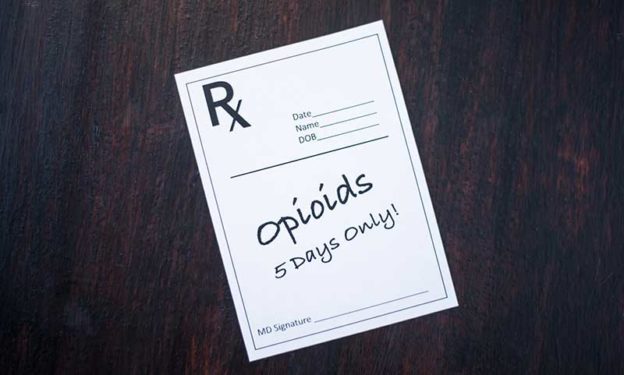New opioid tapering guidelines warn doctors of severe risks in abruptly taking patients off the drugs.
Coming Off Prescription Opioids Safely
For nearly two decades, doctors prescribed opioids in massive quantities across the nation without appropriate regulation or control. The present opioid crisis has caused sudden restrictions to pressure doctors to reduce significantly or stop prescribing these types of drugs altogether. Although the number of opioid prescriptions in the U.S. has been quickly declining, chronic pain patients are unfairly suffering.
These sudden changes in medical guidance covering prescription opioids have left many patients in desperation. People with chronic pain feel abandoned because of an ineffective system on the need for opioids to manage pain. There is no doubt that doctors have been prescribing these drugs often unnecessarily and at dangerous levels. However, we cannot forget who the real victims are.
New Opioid Tapering Guidelines for Physicians
On October 10, 2019, the HHS (U.S. Department of Health and Human Services) published new guidelines for doctors to appropriately taper or discontinue long-term opioid use. Brett P. Giroir, MD, the assistant secretary for health at HHS, clearly states that abrupt changes to a patient’s opioid prescription could be harmful. His main recommendation is that lowering patients’ dosages must be done slowly and carefully. Also, the titration should be provided in a patient-centered, compassionate, and guided way.
For over 26 years, people from all over the world have chosen Waismann Method as their opioid detox provider.
We know the challenges you face and the importance of creating a unique and personal experience for you right from the start.Call for Detox Options 1-800-423-2482
“Abrupt changes to a patient’s opioid prescription could harm them,” states the U.S. Department of Health and Human Services.
 We hope that this new statement will help correct how doctors responded to the 2016 CDC prescribing guidelines when providers were to lower doses when possible. At that time, many doctors began rapidly reducing patients’ prescriptions. In some cases, they completely cut them off with any prior warning or responsible plan.
We hope that this new statement will help correct how doctors responded to the 2016 CDC prescribing guidelines when providers were to lower doses when possible. At that time, many doctors began rapidly reducing patients’ prescriptions. In some cases, they completely cut them off with any prior warning or responsible plan.
Although the CDC reiterates that the guideline was not for those suffering from pain related to cancer, palliative, or end-of-life care, many patients were physically dependent. This sudden discontinuation was tragic. Many people found themselves in such a state of desperation; they turned to street drugs, or even worse, they chose to end their lives.
Concern About Prescribing Guidelines
The earlier efforts on rapidly reducing opioids for all pain patients have backfired in many ways. In early 2019, both the CDC and the FDA put out statements warning physicians of the dangers of sudden discontinuation of prescription opioids or rapid reduction of dosage. Health care professionals are becoming increasingly concerned with governmental and non-governmental agencies’ continual efforts to incentivize dose reductions, which are responsible for so many placing patients in harm’s way.
Dr. Steven Kertesz, a professor of medicine at the University of Alabama and the lead author of the CDC letter, says, “A growing body of research is undermining the foolish assumption that because pills have gone down, safety has been created. Tapering might help some patients if you do it 100% correctly…and in reality, we are mostly doing it wrong.”
Medically Assisted Opioid Treatment
As opioid treatment specialists for over two decades, we at the Waismann Method® know that the spotlight goes away from the patient when the diagnosis becomes the focus. Health care professionals must address the whole person. Medical and emotional conditions, present and past, need to be part of this assessment. More importantly, we need to discuss their treatment expectations, perspectives, and pain goals with patients. Rarely, a responsible treatment plan will be able to eliminate pain. Patients deserve empathy, respect, and adequate time to be heard understood and treated. If we don’t take care of the person behind the symptoms, the root condition will be forgotten. After that, treatment will likely fail.
A Different Approach to Detoxing
For all the reasons mentioned previously, we detox patients from opioids in an accredited hospital. Their procedure occurred in a private room and was treated like all other patients suffering from a medical condition. Our patients receive treatment based on their specific health, dependence, and emotional needs instead of a pre-set protocol dictated by an opioid tapering guideline with a plan. The goal of our treatment is to get patients through opioid withdrawal. Getting them through the critical part of the detox safely, quickly, and as comfortably as possible is essential.
Conclusion
Conclusively, being off opioids allows for a more accurate emotional and physical diagnosis. It will enable the patient’s physiological and psychological state to be present without the effects of opioids. Furthermore, often patients are happy to realize that their pain level is a lot lower than they first thought due to the consequences of hyperalgesia, a condition that affects so many and is often unknown.
The takeaway is that people are complex beings. There is not one fit-all answer, treatment, or guideline that will work for everybody. As health care professionals, we need to stop, hear, and understand the patient.






